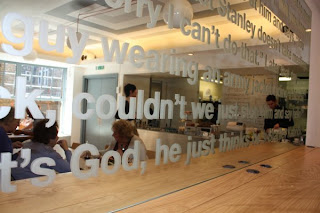
This week as a respite from the demoralising effects of imminent redundancies at work, I treated myself to lunch in the cafeteria of the Whitechapel Gallery, which, if anything, is even more expensive than before the refurb', but a civilised retreat from the Front, where I've fielded nothing but complaints all week.
Along one wall is a mirror inscribed with a joke about Stephen Spielberg and Stanley Kubrick. I can't quote it verbatim, but it goes something like this:
Stephen Spielberg died and at the Pearly Gates was asked by Saint Peter if there was anything he wanted. Spielberg said he wanted to meet Stanley Kubrick, but St Peter demurred, explaining that it was impossible, Kubrick was a very busy man and never saw visitors. Then Spielberg noticed an old white-bearded man riding by on a bicycle and asked, "Isn't that Kubrick? Can't I speak to him?". "No", replied St Peter, "That's not Stanley Kubrick. That's God. He only thinks he's Stanley Kubrick."






















































